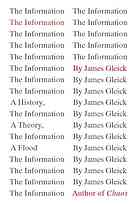History of Information Science
People have been interested in information as a means of communication for a long time.
You want to know who Claude Shannon was and what he means to the field.
If you are curious, and only if you are seriously curious, you might want to look at his original article. It has been cited over 64,000 times.
Shannon, C. E. (1948). A Mathematical Theory of Communication.
The Bell System Technical Journal, 27, 379-423, 623-656.
Read these two chapters and be ready to discuss them in class

Gleick, J. (2011).
The information: A history, a theory, a flood.
New York, NY: Pantheon Books.
-
read chapter chapter 5, A nervous system for the Earth. As you read it, think about:
⇒ the concept of creating meaning from nothing more than the position of a switch (p. 143)
⇒ the concept of a common sense of time (p. 148)
⇒ the concept of a common sense of encoding (p. 152) -
read chapter chapter 6, New wires, new logic. As you read it, think about:
⇒ Vannevar Bush's comment about the value not of being able to manipulate figures, but rather to be skilled in the use of symbolic logic (p. 172)
⇒ the idea that language is just the symbolic coding of meaning (pp. 177-178)
⇒ the concept that numbers may be used to encode all reasoning (p. 185)
If the item on the Napoleonic semaphore in chapter 5 piqued your interest ...

Look at the video that precedes Hugh Schofield 16 June 2013 article on BBC news, How Napoleon's semaphore telegraph changed the world.
[top]
Glance at these before class and be ready to discuss them in class
Saracevic, T.(2010).
Information science.
In M.J. Bates (Ed.), Encyclopedia of Library and Information Sciences (3rd edition)
New York, NY: CRC Press.
look at pages 2577-2585 for today.
If we go to the Association for Information Science and Technology (ASIS&T) home page, we see that it has been around since 1937. But what was special about 1937 and why did it get its start in that year?
When we go to the History of Information Science page, we see something interesting about the Chronology of Information Science and Technology. What is is?
Optional readings
If you want to know more about Grace Hopper, read Grudin, J., & Williams, G. (November 01, 2013). Two women who pioneered user-centered design. Interactions, 20, 6, 15-20.
[top]


